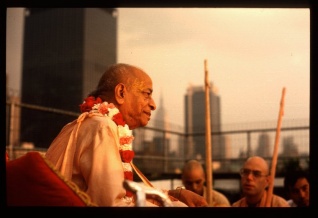ES/CC Adi 7.22: Difference between revisions
Caitanyadeva (talk | contribs) (Created page with "E022 <div style="float:left">'''Spanish - Śrī_Caitanya-caritāmṛta|Śrī Caitanya-caritāmṛta...") |
Caitanyadeva (talk | contribs) No edit summary |
||
| (One intermediate revision by the same user not shown) | |||
| Line 1: | Line 1: | ||
[[Category:ES/Śrī_Caitanya-caritāmṛta_-_Ādi-līlā_-_Capítulo_07|E022]] | [[Category:ES/Śrī_Caitanya-caritāmṛta_-_Ādi-līlā_-_Capítulo_07|E022]] | ||
<div style="float:left">'''[[Spanish - Śrī_Caitanya-caritāmṛta|Śrī Caitanya-caritāmṛta]] - [[ES/CC Adi|Ādi-līlā]] - [[ES/CC Adi 7| Capítulo 7: Los cinco aspectos del Señor Caitanya]]'''</div> | <div style="float:left">'''[[Spanish - Śrī_Caitanya-caritāmṛta|Śrī Caitanya-caritāmṛta]] - [[ES/CC Adi 7: Los cinco aspectos del Señor Caitanya|Ādi-līlā]] - [[ES/CC Adi 7: Los cinco aspectos del Señor Caitanya| Capítulo 7: Los cinco aspectos del Señor Caitanya]]'''</div> | ||
<div style="float:right">[[File:Go-previous.png|link=ES/CC Adi 7. | <div style="float:right">[[File:Go-previous.png|link=ES/CC Adi 7.20-21| Ādi-līlā 7.20-21]] '''[[ES/CC Adi 7.20-21|Ādi-līlā 7.20-21]] - [[ES/CC Adi 7.23|Ādi-līlā 7.23]]''' [[File:Go-next.png|link=ES/CC Adi 7.23|Ādi-līlā 7.23]]</div> | ||
<!-- BEGIN VANISOURCE VERSION PAGE LINK--> | <!-- BEGIN VANISOURCE VERSION PAGE LINK--> | ||
<div style="clear:both;"></div> | <div style="clear:both;"></div> | ||
<div class="center"> | <div class="center"> | ||
'''<big>[[Vanisource:CC_Adi_7. | '''<big>[[Vanisource:CC_Adi_7.22|Haga clic aquí para ver original en inglés]]</big>''' | ||
</div> | </div> | ||
---- | ---- | ||
| Line 12: | Line 12: | ||
{{RandomImage|Spanish}} | {{RandomImage|Spanish}} | ||
==== TEXTO | ==== TEXTO 22 ==== | ||
<div class="verse"> | <div class="verse"> | ||
:punaḥ punaḥ piyāiyā haya mahāmatta | |||
:nāce, kānde, hāse, gāya, yaiche mada-matta | |||
</div> | </div> | ||
| Line 22: | Line 23: | ||
<div class="synonyms"> | <div class="synonyms"> | ||
''punaḥ punaḥ'' —una y otra vez; ''piyāiyā'' —haciendo beber; ''haya'' —se vuelve; ''mahā-matta'' —muy extático; ''nāce'' —baila; ''kānde'' —llora; ''hāse'' —ríe; ''gāya'' —canta; ''yaiche'' —como si; ''mada-matta'' —está embriagado.. | |||
</div> | </div> | ||
| Line 30: | Line 31: | ||
<div class="translation"> | <div class="translation"> | ||
''' | '''Śrī Pañca-tattva bailaban y bailaban, y así, hicieron más fácil poder beber el néctar del amor por Dios. Bailaron, lloraron, rieron y cantaron como locos, y de esta manera distribuyeron el amor por Dios'''. | ||
</div> | </div> | ||
| Line 37: | Line 38: | ||
<div class="purport"> | <div class="purport"> | ||
En general, la gente no puede comprender el verdadero significado de cantar y bailar. Al describir a los Gosvāmīs, Śrīnivāsa Ācārya afirma: ''kṛṣṇotkīrtana-gāna-nartana-parau'': No sólo Śrī Caitanya Mahāprabhu y Sus compañeros mostraron esta manera de cantar y bailar, sino que los Seis Gosvāmīs la continuaron en la generación siguiente. El actual movimiento para la conciencia de Kṛṣṇa sigue el mismo principio, y por tanto, sólo cantando y bailando, hemos encontrado acogida favorable por todo el mundo. Sin embargo, hay que comprender que esta manera de cantar y bailar no pertenece a este mundo material. Se trata en realidad de actividades trascendentales, porque cuanto más se entrega alguien al canto y a la danza, más puede saborear el néctar del amor trascendental por Dios. | |||
</div> | </div> | ||
<div style="float:right">[[File:Go-previous.png|link=ES/CC Adi 7. | <div style="float:right">[[File:Go-previous.png|link=ES/CC Adi 7.20-21|Ādi-līlā 7.20-21]] '''[[ES/CC Adi 7.20-21|Ādi-līlā 7.20-21]] - [[ES/CC Adi 7.23|Ādi-līlā 7.23]]''' [[File:Go-next.png|link=ES/CC Adi 7.23|Ādi-līlā 7.23]]</div> | ||
__NOTOC__ | __NOTOC__ | ||
__NOEDITSECTION__ | __NOEDITSECTION__ | ||
Latest revision as of 00:06, 5 April 2023

TEXTO 22
- punaḥ punaḥ piyāiyā haya mahāmatta
- nāce, kānde, hāse, gāya, yaiche mada-matta
PALABRA POR PALABRA
punaḥ punaḥ —una y otra vez; piyāiyā —haciendo beber; haya —se vuelve; mahā-matta —muy extático; nāce —baila; kānde —llora; hāse —ríe; gāya —canta; yaiche —como si; mada-matta —está embriagado..
TRADUCCIÓN
Śrī Pañca-tattva bailaban y bailaban, y así, hicieron más fácil poder beber el néctar del amor por Dios. Bailaron, lloraron, rieron y cantaron como locos, y de esta manera distribuyeron el amor por Dios.
SIGNIFICADO
En general, la gente no puede comprender el verdadero significado de cantar y bailar. Al describir a los Gosvāmīs, Śrīnivāsa Ācārya afirma: kṛṣṇotkīrtana-gāna-nartana-parau: No sólo Śrī Caitanya Mahāprabhu y Sus compañeros mostraron esta manera de cantar y bailar, sino que los Seis Gosvāmīs la continuaron en la generación siguiente. El actual movimiento para la conciencia de Kṛṣṇa sigue el mismo principio, y por tanto, sólo cantando y bailando, hemos encontrado acogida favorable por todo el mundo. Sin embargo, hay que comprender que esta manera de cantar y bailar no pertenece a este mundo material. Se trata en realidad de actividades trascendentales, porque cuanto más se entrega alguien al canto y a la danza, más puede saborear el néctar del amor trascendental por Dios.